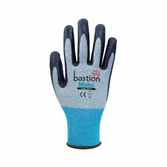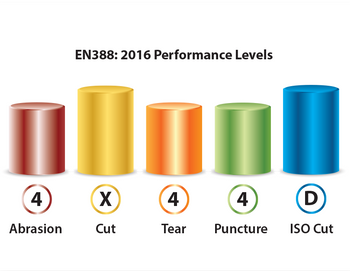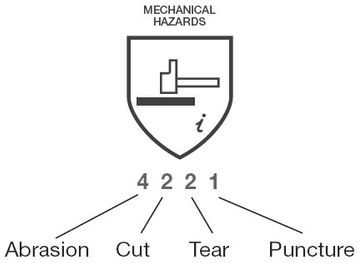 |
 |
 |
 |
Level 5 Cut Gloves
Industrial strength - Heavy Duty - Superior Performance
The European Standard EN388 (2003) covers the test requirements for safety gloves that are sold as protection against mechanical risks. It is generally accepted that the majority of occupational hand injuries are caused by cuts and abrasions, with most of the more serious injuries due to cuts.
Gloves that conform to EN388 are rated using four numbers; these numbers tell you how resistant the gloves are to mechanical hazards. You can use this information to ensure that your workers are protected in an appropriate way.
Work gloves that conform to EN388 will be marked with this shield.
 |
 |
Under the shield will be four numbers. These show the level of protection according to EN388. Some gloves may be marked ‘x’ for a particular category. This means that this glove was not tested for that category.
Abrasion Resistance
The first number in EN388 tells you how well the gloves resist abrasion. The number will vary between one and four. Abrasion resistance is important for all types of handling but is especially important for handling rough materials, such as bricks. It is important to have a high abrasion rating on gloves used in work areas such as gardening and construction work.
Blade Cuts Resistance
The second number in the EN388 rating shows you the gloves’ resistance to blade cuts. This number ranges between one and five. Work gloves that have a higher rating in this category provide better protection against sharp objects, such as knives and glass. Gloves with a high level of blade cut resistance are ideal for workers who handle sheet metal, glass, and sharp tools.
Tear Resistance
The gloves’ resistance to tears is shown by the third number is the EN 388 rating. This number ranges between one and four. Gloves with a high level of tear resistance are very durable and will withstand demanding work such as construction, landscaping, and heavy handling.
Puncture Resistance
The final number in the EN 388 rating indicates the gloves’ resistance to punctures. This number will be between one and four. Gloves with high levels of puncture resistance provide greater protection against hazards such as needles, thorns, and syringes. This type of glove is ideal for medical and waste work.
To choose the correct type of work gloves, it is essential to consider the type of task for which they will be used. By assessing the types of hazards to which workers will be exposed, you will understand the type of protective gloves they will need.
Once a glove has been tested its performance will be represented using the EN388 icon. This icon must be printed on each glove so that it is easy to tell how much resistance the glove provides against the four mechanical risks.
While the maximum score on each performance test would be 4544 this is not to be regarded as the ‘best’ score. Each task will have different risks involved and therefore need a glove with suitable attributes. For example, if you are selecting a glove to use while painting walls then you’ll be very interested in the flexibility and durability of the glove, but not so concerned about its resistance to cuts and punctures. In this case, a glove with an EN388 rating of 4131 may be the best for the task.
Why is EN388 testing important?
The EN388 Standard tests reflect the hazards that glove wearers are likely to face in the widest range of handling tasks across the broadest range of industries. Presenting the results of these tests as performance numbers – and printing the performance icon on each glove – makes it easier to assess the suitability of a glove for a particular task.
Gloves are a necessity for your basic personal protective equipment (PPE).-
Vinyl gloves:
A popular choice among the cleaning industry. Vinyl gloves provide basic protection. They are available as powder-free gloves and lightly powdered gloves -
Nitrile gloves:
Made from synthetic rubber, nitrile gloves are an ideal alternative when latex allergies are a concern -
Latex gloves:
Made from natural rubber. Latex gloves have a higher puncture resistance and have greater dexterity and comfort compared to nitrile gloves -
Polyethylene gloves:
A clear low-density polyethylene glove used in child care and food preparation industries.
GLOVE TYPE |
DEFINITION |
ADVANTAGE |
PROTECTION LEVEL |
CONCERNS |
| Latex Gloves | Made of Natural Rubber | Highest comfort, flexibility, fit and tactile sensitivity | Bacteria, viruses | Some people have a latex allergy so choose vinyl or nitrile instead. |
| Nitrile Gloves | Made of Synthetic Material | Stretchy, Durable | Chemicals, viruses | More costly than vinyl gloves and not reusable |
| Vinyl Gloves | Made of Synthetic material | Cost-efficient synthetic option, comfortable | Chemicals | Do not tolerate abrasion and tear easily. Not suitable for high-risk usage. |
GLOVES AVAILABLE TO PURCHASE ONLINE
 |
 |
 |
 |
Join us on socials |
|
